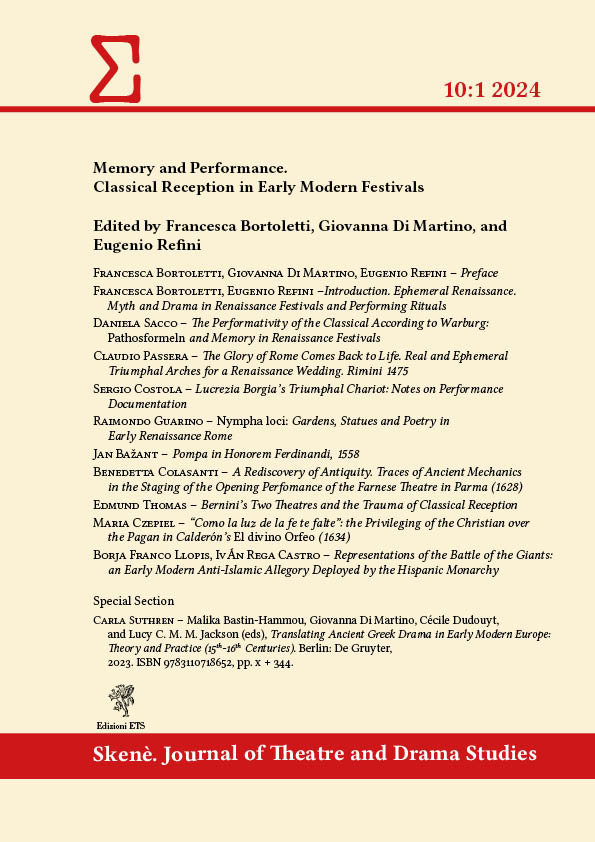The Performativity of the Classical According to Warburg: Pathosformeln and Memory in Renaissance Festivals
DOI:
https://doi.org/10.13136/sfqtd319Abstract
The purpose of this article is to examine the performative aspect implicitly embedded in Warburg’s thinking about Renaissance festivals, starting with the formulation of the term Pathosformel introduced in the text Dürer and Italian Antiquity (1905). Here Warburg identifies Poliziano’s Fabula di Orfeo as “the first Italian tragedy” and complements and extends the insights from the essay Costumi teatrali per gli intermezzi del 1589 (1895). The lessons of Burkhardt and Nietzsche played a crucial role in shaping Warburg’s understanding of intermedi as a form of transition between art and reality, as opposed to theatre, which is based on words and text. These intermedi are characterised by their high expressive mimicry qualities, and they are embryonic forms of the new art to come, which is accompanied by an implicit tragic element. Warburg shifts from mimetic models associated with iconology to a study of art history where he focuses on the creative principle as the tragic matrix of the artistic act. This allows him to integrate performative themes more effectively within the cultural understanding of art.
Keywords: Aby Warburg; Renaissance festivals; Pathosformel; intermedi; performance
Downloads
Published
Issue
Section
License
Copyright (c) 2024 Skenè. Journal of Theatre and Drama Studies

This work is licensed under a Creative Commons Attribution 4.0 International License.
Open Access Policy
This journal provides immediate open access to its content on the principle that making research freely available to the public supports a greater global exchange of knowledge.
This Journal is a CC-BY 4.0 publication (https://creativecommons.org/licenses/by/4.0/). This Licence allows others to share the work with an acknowledgement of the work’s authorship and initial publication in this Journal, providing a link to the Licence and explicitly underlining any change (full mention of Issue number, year, pages and DOI is required).
- The Author retains (i) the rights to reproduce, to distribute, to publicly perform, and to publicly display the Article in any medium for any purpose; (ii) the right to prepare derivative works from the Article; and (iii) the right to authorise others to make any use of the Article so long as the Author receives credit as Author and the Journal in which the Article has been published are cited as the source of first publication of the Article. For example, the Author may make and distribute copies in the course of teaching and research and may post the Article on personal or institutional Web sites and in other open-access digital repositories.
- The Author is free to enter into separate, additional contractual arrangements for the non-exclusive distribution of the Journal’s published version of the work, with an acknowledgement of its initial publication in this Journal and explicitly underlining any change (full mention of Issue number, year, pages and DOI is required).
- The Author is permitted and encouraged to post their work online after the evaluation process has been successfully passed, as it can lead to productive exchanges as well as to a wider dissemination of the published work.

